
Splittertarnmuster, Splittertarn or Splittermuster (splinter-pattern) is a four-colour military camouflage pattern developed by Germany in the late 1920s, first issued to the Reichswehr in 1931.

Splittertarnmuster, Splittertarn or Splittermuster (splinter-pattern) is a four-colour military camouflage pattern developed by Germany in the late 1920s, first issued to the Reichswehr in 1931.
Splittertarnmuster was first printed on the newly designed and issued triangular tent/poncho called the dreiecks zeltbahn (triangle tarpaulin), just as the Italian 1929 telo mimetico began as a tent pattern. [1] Known in German as Buntfarbenaufdruck 31 (colourful print 31), for its year of introduction, splittertarn was later issued to practically all regular military (Wehrmacht) units. [lower-alpha 1] The pattern consists of a disruptive, zig-zag pattern of hard-edged wood-brown and medium green polygons printed on a light field-grey or tan background. A random pattern of green dashes, called raindrops, was applied in places to improve the camouflage effect.
Proposed in 1931 and introduced in 1932, the four-colour camouflage patterns incorporated "splinters" on top of the 1918 colour pattern. The pattern included ochre, rust and brown overlaid on a green foundation, with sharp corners between coloured patches. This new pattern was printed on zeltbahn (triangular tent) material and could also be used as a camouflage rain poncho in the field. Both sides of the material showed the same pattern but the printing was brighter on one side.
A subdued grey-beige tint replaced the yellow-ochre colour. On top of this background, green and brown irregular patterns were screen-printed. A final innovation applied to this camouflage colour printing were the "splinters" irregularly printed on the fabric. Directional, dark-green dashed lines ("grass" or "rain") were printed in selected areas to help break up the silhouette. Many similar rain pattern designs inspired by splittermuster were made after the war by Warsaw Pact countries. [2] During the war, cost-saving measures required textiles to be printed with changed colours and many of the lower-cost two-colour options were abandoned. These cost-saving measures caused significant deviations from the original colour patterns. In 1941 splitter pattern jump smocks were issued to German paratroops for the invasion of Crete. [1]
In 1942, a Tarnhemd (smock) and Tarnhelmüberzug (helmet cover), both of a lightweight herringbone twill linen, were issued. Only one side of each was printed in splitter pattern; the other side was left white for snow camouflage. [3]
In April 1942, a Wintertarnanzug suit consisted of a padded jacket, trousers, separate hood and mittens. These were also printed only on one side and were left white on the other side. Only a small amount of this was produced; a similar set made in mouse grey or field grey were more common.
Many unofficial garments and helmet covers were produced as field expedients or were tailor-made, mostly from zeltbahn material. These included versions of the service dress uniform, parachute-jump smocks, field jackets, rucksacks and panzer jackets. Later materials included rayon. [4]

Luftwaffen-Splittermuster 41 (also: Buntfarbenaufdruck) is a Luftwaffe version with a smaller splinter and a more-complicated pattern, from probably not earlier than 1941. The Luftwaffe's variant of splittermuster 31 is known in the literature as "splinter camouflage B". The pattern was used for the Fallschirmjäger's parachute Knochensack jump smock and Luftwaffe Field Division field jacket to be manufactured. Other material produced with this equipment included camouflage helmet covers, ammunition bandoliers and grenade bags. The production of the splinter camouflage B ended in 1944. [5] [6]

During World War II, Bulgarian paratroopers were equipped with Luftwaffe-Splittermuster 41. Its typical square look with the dashed lines has been the national camouflage of Bulgaria and has continually evolved. It was worn as a one piece boilersuit [7] and as a two piece suit for paratroops, border troops and mountain troops. The mountain version had large patches of reinforcing materials on the knees, elbows, wrists and shoulders and black patches under the arms, around the collar and in the crotch. A Soviet style large beret, pulled down to the left, was worn. [8]
For the paratroopers in 1953, a three-colour pattern was introduced, which had been derived directly from the bright colours printed in 1941 for the German paratroopers. The dashed lines here were not aligned uniformly in one direction but could vary within a limited framework. The colours were based on the model but used other tones. The Bulgarian splinter 53 was later issued to special forces and worn until 1991.
The Bulgarian Splittertarnmuster was developed in the 1960s and 1970s, with varied shapes and colors. In 1979, the army released another version of the Bulgarian paratroopers colored imprint of 1941, with wavy dotted lines, which was again closer to the German model. In 1991, the production of the pattern was started. In 1997, the current three-color printing for bright colors was launched for the entire Bulgarian army, with the dashed lines appearing again in a spidery waveform.


From 1990, the Swedish armed forces carried a four-color M90 Splittertarnmuster, which is close to the bright colors printed 31 through the resumption of sharp linear triangular patches. The differences are in the schematic, because the spots are not distributed freely but directly abut and are not crossed by the dashed lines. Blue, khaki, and light green patches are distributed on a dark green background. This camouflage pattern was exported to Latvia for wear as part of SFOR forces in Bosnia and Herzegovina.

Flecktarn is a family of three-, four-, five- or six-color disruptive camouflage patterns, the most common being the five-color pattern, consisting of dark green, grey-green, red brown, and black over a light green or tan base depending on the manufacturer. The original German five-color pattern was designed for use in European temperate woodland terrain. A three-color variation called Tropentarn is intended for arid and desert conditions; the German Bundeswehr wore it in Afghanistan.

A combat uniform, also called field uniform, battledress or military fatigues, is a casual type of uniform used by military, police, fire and other public uniformed services for everyday fieldwork and combat duty purposes, as opposed to dress uniforms worn in functions and parades. It generally consists of a jacket, trousers and shirt or T-shirt, all cut to be looser and more comfortable than more formal uniforms. Design may depend on regiment or service branch, e.g. army, navy, air force, marines, etc. In the army branches, fabrics tend to come in camouflage, disruptive pattern or else green, brown or khaki monochrome, in order to approximate the background and make the soldier less visible in nature. In Western dress codes, field uniform is considered equivalent to civilian casual wear. As such, field uniform is considered less formal than service dress uniform, generally aimed at office or staff use, as well as mess dress uniform, and full dress uniform.
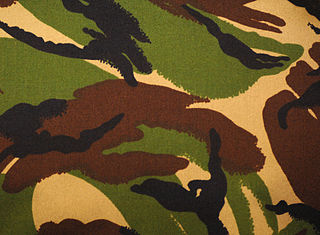
Disruptive Pattern Material (DPM) is the commonly used name of a camouflage pattern used by the British Armed Forces as well as many other armed forces worldwide, particularly in former British colonies.

The Denison smock was a coverall jacket issued to Special Operations Executive (SOE) agents, the Parachute Regiment, the Glider Pilot Regiment, Air Landing Regiments, air observation post squadrons, Commando units, and other Commonwealth airborne units, to wear over their Battle Dress uniform during the Second World War. The garment was also issued as standard to the scout and sniper platoons of line infantry battalions.

Military camouflage is the use of camouflage by an armed force to protect personnel and equipment from observation by enemy forces. In practice, this means applying colour and materials to military equipment of all kinds, including vehicles, ships, aircraft, gun positions and battledress, either to conceal it from observation (crypsis), or to make it appear as something else (mimicry). The French slang word camouflage came into common English usage during World War I when the concept of visual deception developed into an essential part of modern military tactics. In that war, long-range artillery and observation from the air combined to expand the field of fire, and camouflage was widely used to decrease the danger of being targeted or to enable surprise. As such, military camouflage is a form of military deception in addition to cultural functions such as political identification.

Disruptive Pattern Camouflage Uniform (DPCU), also nicknamed Auscam, jelly bean camo, or hearts and bunnies is a five-colour military camouflage pattern used by the Australian Defence Force. Replacing the jungle greens used from WWII, it was developed and tested during the late 1970s and early 1980s. The uniform was trialled in 1987, with it being slowly introduced in late 1989, with the last production and discontinuation of the jungle greens being in late 1990. Jungle greens were last issued in late 1991 for Australian Regular Army, and late 1994 for Australian Army Reserve.

The uniforms of the British Army currently exist in twelve categories ranging from ceremonial uniforms to combat dress. Uniforms in the British Army are specific to the regiment to which a soldier belongs. Full dress presents the most differentiation between units, and there are fewer regimental distinctions between ceremonial dress, service dress, barrack dress and combat dress, though a level of regimental distinction runs throughout.

The M90 camouflage is the camouflage pattern for the uniform system 90, used by the Swedish Armed Forces. The pattern consists of hard lined geometric shapes, aiming to create a camouflage pattern effective in the temperate forests and plains of Sweden. It is affectionately known among Swedish soldiers as lövhögen, or "the leaf pile." In addition to the standard pattern, which was designed with Swedish forests in mind, desert and winter variants were later developed. The M90 uniform pattern was introduced into active service in the late 1980s, and was adapted by the entire force by the late 1990s.

The Afghanka is a type of military uniform system developed and issued by the Soviet Army in the early 1980s, still in use today in some Post-Soviet states in many different variants. The name Afghanka is an unofficial popular slang term in Russian for the uniform, derived from its prolific use during the Soviet–Afghan War. All the non-sand coloured versions of the M88 are not called Afghanka.

The lizard pattern is a family of many related designs of military camouflage pattern, first used by the French Army on uniforms from 1947 to the late 1980s. It was based on the British paratroopers' Denison smock. The use of the pattern is widespread in Africa, despite its association with France, because armed factions and militaries tend to obtain them from whichever source has it available.

The following is a general overview of the Heer main uniforms, used by the German Army prior to and during World War II.
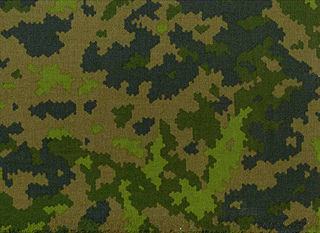
The M05, sometimes known as the M05 Terrain Pattern, is a family of military camouflage patterns used by the Finnish Defence Forces on uniforms and other equipment. The pattern is licensed by the Finnish Defence Forces and became available to the public on 26 September 2016.
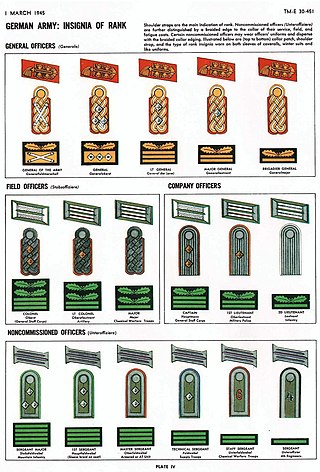
The Heer as the German army and part of the Wehrmacht inherited its uniforms and rank structure from the Reichsheer of the Weimar Republic (1921–1935). There were few alterations and adjustments made as the army grew from a limited peacetime defense force of 100,000 men to a war-fighting force of several million men.
The rank insignia of the federal armed forces of the Federal Republic of Germany indicate rank and branch of service in the German Army, German Air Force, or the German Navy.

Splinter pattern camouflage is a military camouflage pattern consisting of polygons.

The Luftwaffe was the air force of Nazi Germany prior to and during World War II. Luftwaffe styles of uniform and rank insignia had many unique features between 1935 and 1945. By Hitler's decision on February 26, 1935, the Luftwaffe was to be officially the third branch of the Wehrmacht as of March 1, 1935. The new Luftwaffe was faced with the problem of uniforms, as they wanted a uniform distinct from those of the other two branches of the Wehrmacht and also wanted a clear differentiation in dress of military and civilian flyers.
Windproof Smocks are clothing. They usually come with hoods and matching trousers worn as over garments to prevent cold air, and in some cases water, passing through.

M1929 Telo mimetico was a military camouflage pattern used by the Italian Army for shelter-halves and later for uniforms for much of the 20th century. Being first issued in 1929 and only fully discontinued in the early 1990s, it has the distinction of being the first printed camouflage pattern for general issue, and the camouflage pattern in longest continuous use in the world.
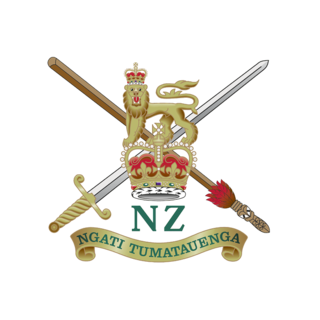
The New Zealand Army uniform has changed over the years from that of the original Armed Constabulary of the 1800s to the modern Army Combat Uniform style in use by the majority of world armies today. While British Army influence has always been strong, distinctive New Zealand features have gradually developed. From 2013 the New Zealand Army uniform underwent a complete redesign with a new and distinctive camouflage pattern unique to the NZDF.
German World War II camouflage patterns formed a family of disruptively patterned military camouflage designs for clothing, used and in the main designed during the Second World War. The first pattern, Splittertarnmuster, was designed in 1931 and was initially intended for Zeltbahn shelter halves. The clothing patterns developed from it combined a pattern of interlocking irregular green, brown, and buff polygons with vertical "rain" streaks. Later patterns, all said to have been designed for the Waffen-SS by Johann Georg Otto Schick, evolved into more leaf-like forms with rounded dots or irregular shapes. Camouflage smocks were designed to be reversible, providing camouflage for two seasons, whether summer and autumn, or summer and winter (snow). Distribution was limited to the Waffen-SS, ostensibly because of a patent, though variants were used by other units, including the Luftwaffe. Production was limited by shortage of materials, especially of high quality waterproof cotton duck.